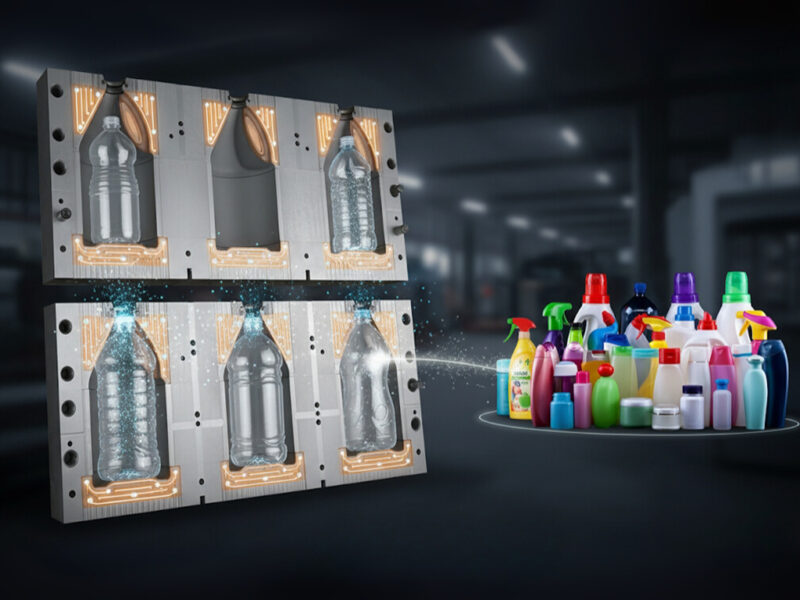
Blow molding is one of the most important technologies in plastics processing, widely used to produce hollow products such as bottles, jars, jerrycans, and tanks. In the article below, Thái Dương Plastics explains key technical features, the manufacturing process, and how to choose the right blow-molding method for each product.
What is blow molding?
Blow molding is a technology for forming hollow parts by using compressed air to inflate a plastic parison or preform inside a closed mold. As air is blown in, the plastic expands against the mold surface and retains its shape after cooling.
Compared with injection molding-which is ideal for solid, complex parts with tight tolerances-blow molding is the optimal choice for hollow products. Injection molding offers high precision but requires expensive tooling, whereas blow molding, while less precise, delivers high productivity and cost efficiency for large-volume production.

Materials used
Resins for blow molding must withstand drawdown while maintaining stable wall thickness. PET is widely used for beverage bottles thanks to its clarity and mechanical strength. HDPE and PP suit chemical jerrycans and household bottles due to good chemical resistance and low weight. PVC, PC, and TPE can also be used for specific products. For premium applications, multilayer structures combine different resins to enhance barrier properties and reduce cost-for example, using recycled material in the core layer.
Advantages over other techniques
Compared with alternative processes, blow molding offers clear advantages:
- Forms seamless, hollow parts that are lightweight yet durable.
- Short cycle times, stable throughput, and high productivity.
- Lower tooling and production costs-well suited to larger-volume hollow items.
- Flexible capacities and designs-from a few milliliters to hundreds of liters.
Overview of the blow-molding process
A standard blow-molding workflow includes:
- Material preparation: Dry resin to remove moisture and prevent defects.
- Parison/preform formation: Using methods such as EBM, ISBM, or IBM.
- Mold clamping and air blowing: The mold closes around the parison/preform; compressed air inflates it to the mold walls.
- In-mold cooling: Water channels stabilize dimensions and wall thickness.
- Part removal and finishing: Deflashing, neck finishing, leak testing, and packing.

Common blow-molding methods
Industry practice centers on three main methods:
Extrusion Blow Molding (EBM)
Molten plastic is extruded into a hollow tube (parison), then clamped in a mold and inflated. Tooling costs are relatively low, making EBM suitable for large-volume parts such as jerrycans, tanks, and common household bottles. Limitations include less uniform wall thickness and flash that often requires post-trim.
Injection Blow Molding (IBM)
A preform is injection-molded first to achieve precise neck/threads, then transferred for blowing. Advantages include smooth surfaces, stable dimensions, and excellent repeatability. IBM is commonly used for small bottles under 1 liter in pharmaceuticals and cosmetics. Constraints include limited container size and higher tooling costs for the injection preform.
Injection Stretch Blow Molding (ISBM)
PET preforms are reheated, axially stretched, and then blown. Molecular orientation yields high mechanical strength, glass-like clarity, and resin savings. ISBM is widely used for PET beverage bottles, but requires precise reheating control and higher equipment investment.

One-stage vs. two-stage blow molding
In ISBM, two production routes are widely used:
- One-stage ISBM
All steps-from preform injection, reheating, stretching, to blowing-occur on a single machine. This reduces preform scuffing, maintains neck/finish quality, and suits small batches and frequent design changes.
- Two-stage ISBM
Preforms are injection-molded first, then reheated and blown on separate equipment. This method supports very large-scale production and is standard in the soft-drink industry. Trade-offs include managing preform inventory and tightly controlling reheat to ensure uniform wall distribution.
How to choose the best blow-molding method
Consider the following when selecting the optimal process:
- For transparent PET bottles with monthly output in the millions, two-stage ISBM is the most efficient option.
- For small bottles under 1 liter in cosmetics, IBM or one-stage ISBM ensures precise neck finishes and excellent surface quality.
- For large jerrycans or tanks, EBM offers better control of wall thickness and is more suitable than the other methods.
Common blow-molding defects and remedies
If process settings and mold design are not tightly controlled, defects can arise. Below are common issues and how to address them:
- Uneven, thin walls: Often caused by parison sag while waiting for the mold to close. Remedy by reprogramming parison thickness (parison control), shortening hang time, and optimizing extruder temperature zones.
- Warpage on large flat areas: Typically due to uneven cooling leading to differential shrinkage. Add stiffening ribs, improve cooling-channel layout, and adjust hold/blow settings.
- Leaks at the neck and shoulder: Occur when clamp force is insufficient or the neck design is suboptimal. Increase blow pressure, inspect mold surfaces, and refine the neck/finish geometry.
- Haze or whitening in PET: Stems from non-uniform preform reheating or suboptimal stretch rate. Balance the reheat profile around the preform circumference and fine-tune stretch speed.

Each blow-molding method has distinct strengths suited to specific products. Businesses should weigh capacity, material, and output requirements to select the right technology. For in-depth support, Thái Dương Plastics is ready to help optimize both design and production. If you need further guidance on any plastic molding technique, please contact Thái Dương Plastics for expert assistance.
Read next: What is plastic molding? Latest processes, advantages, and applications
